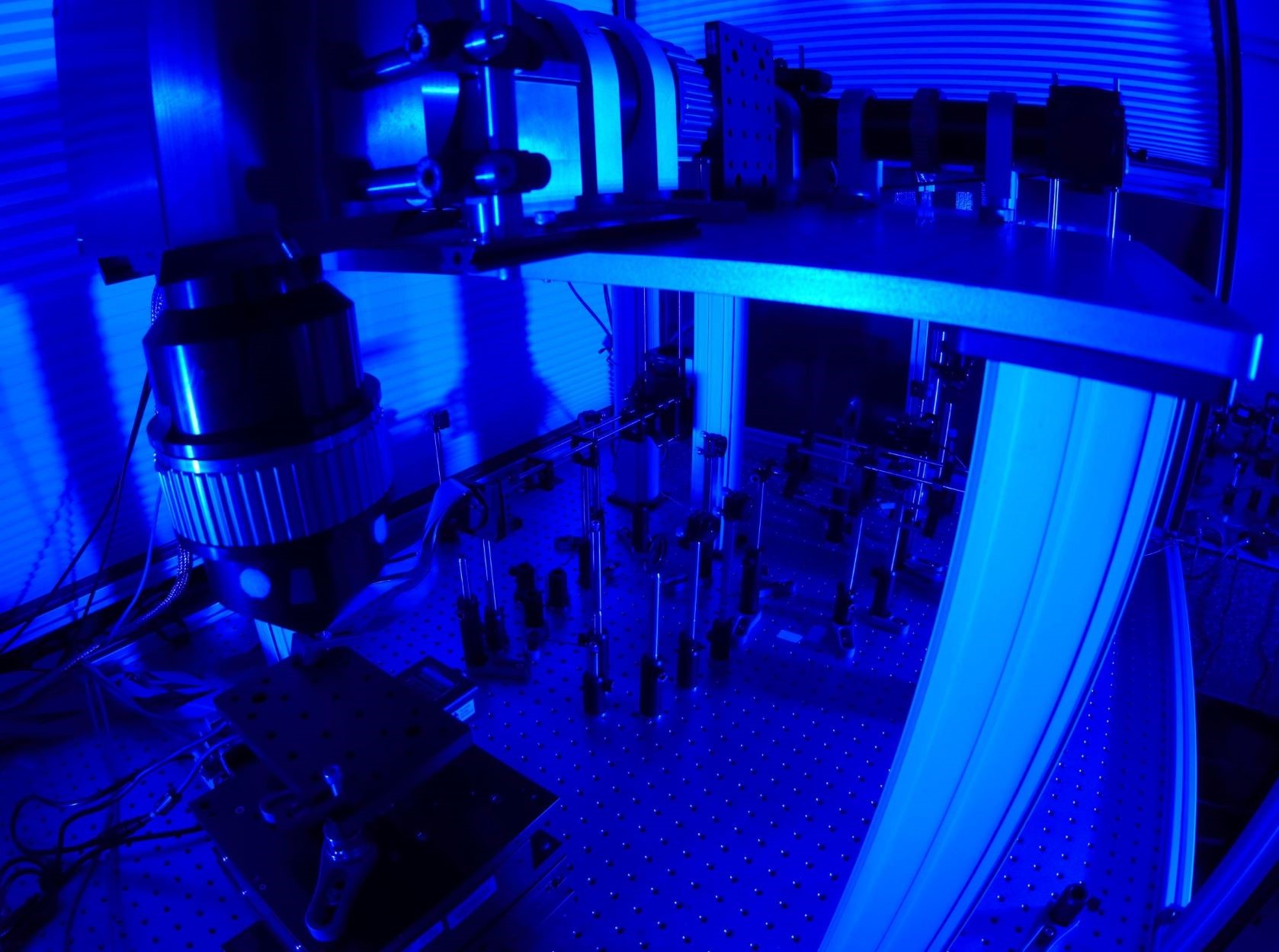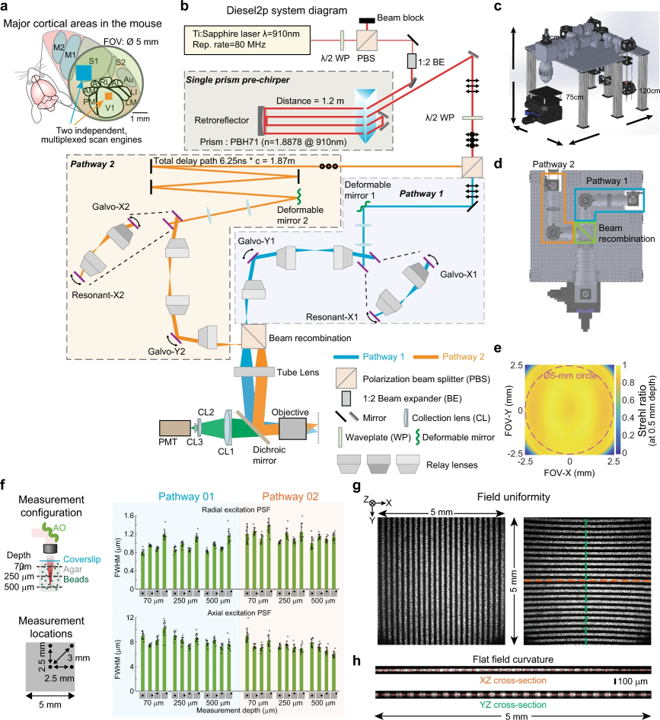Difference between revisions of "Diesel user group"
Ryan.McGreal (talk | contribs) |
Ryan.McGreal (talk | contribs) |
||
| Line 8: | Line 8: | ||
Diesel2p (Dual Independent Enhanced Scan Engines for Large field-of-view Two-Photon imaging) is a multiphoton imaging system designed by the [http://slslab.org/ Smith lab]. With approximately a dozen systems currently in operation or ordered, this custom and fully open-sourced system allows for large field-of view-imaging with two independ scan engines. In addition to Diesel2p, a 4-channel version is in operation at the Chen lab and a three-photon version is currently operated by the Kara lab. | Diesel2p (Dual Independent Enhanced Scan Engines for Large field-of-view Two-Photon imaging) is a multiphoton imaging system designed by the [http://slslab.org/ Smith lab]. With approximately a dozen systems currently in operation or ordered, this custom and fully open-sourced system allows for large field-of view-imaging with two independ scan engines. In addition to Diesel2p, a 4-channel version is in operation at the Chen lab and a three-photon version is currently operated by the Kara lab. | ||
| − | [[File:Blue-fullview-fisheye.jpg | + | [[File:Blue-fullview-fisheye.jpg]] diesel2p objective and stage |
Revision as of 12:01, 7 September 2022
Under Construction
This page will serve as a home for the users of Diesel (Dual Independent Enhanced Scan Engines for Large field-of-view) multiphoton imaging systems
Contents
What is Diesel?
Diesel2p (Dual Independent Enhanced Scan Engines for Large field-of-view Two-Photon imaging) is a multiphoton imaging system designed by the Smith lab. With approximately a dozen systems currently in operation or ordered, this custom and fully open-sourced system allows for large field-of view-imaging with two independ scan engines. In addition to Diesel2p, a 4-channel version is in operation at the Chen lab and a three-photon version is currently operated by the Kara lab.
a Functional cortical areas in the mouse brain are widely distributed. A field-of-view (FOV) of Ø5 mm can encompass multiple brain areas, and independent scan engines can capture ongoing neural activity in multiple cortical areas simultaneously with optimized scan parameters. b Two imaging beams are temporally multiplexed and independently positioned in XY using two sets of resonant-galvo-galvo scan engines. First, overall power is attenuated using a half-wave plate (λ/2 WP) and a polarizing beam splitting cube (PBS). A 2X beam expander (1:2 BE) enlarges the beam for the clear aperture of the deformable mirrors adaptive optics (AO). A custom single-prism pre-chirper offsets system dispersion to maintain transform-limited pulses at the focal plane. A second λ/2 WP and PBS pair divides the beam into two pathways. Pathway 2 (s-polarization in orange) passes to a delay arm where it travels 1.87 m further than Pathway 1 using mirrors, thus delaying it by 6.25 ns relative to Pathway 1 (p-polarization in blue). Both pathways each proceed to deformable mirrors for adjusting the focal plane and correcting optical aberrations before being directed to resonant-galvo-galvo scan engines. All scanning mirrors are optically relayed to each other. Each pathway then passes through a scan lens before being combined with a beam recombination relay. A tube lens and an infrared-reflective dichroic mirror relay the two multiplexed beams onto the back aperture of the objective. Fluorescence (green) is directed to a photomultiplier tube (PMT) via an assembly of collection lenses (CL1, CL2, CL3). c An oblique view of a 3-D model of the system and its footprint. d A top view with the arrangement of the two scan engines highlighted. e Plot of the model Strehl ratio across the scan area indicates diffraction limited performance (Strehl ratio > 0.8) across ~25 mm2, significantly larger than the area of the dashed 5-mm diameter circle (~19.6 mm2) by ~28%. f Multiphoton excitation PSF measurements were made with subresolution beads (0.2 µm) in agar under a coverslip at three depths and four locations, for both of the AO-equipped, temporally multiplexed beam pathways. FWHM of the Gaussian fits for measurements from the fluorescence beads radially and axially are calculated and plotted. Eight beads (n = 8) at each locations are measured, except that there are 7 beads (n = 7) measured on axis at the depth of 500 µm. Data are presented as mean values ± S.D. g XY images of a calibrated, structured fluorescent sample with a periodic line pattern (5 lines per millimeter) in two orientations acquired under the full scan range of the system. Each image shows 25 lines on the top edge (left image) and on the left edge (right image), receptively, verifying a 5 × 5 mm FOV. h The XZ image along the orange dashed line and the YZ image along green dashed line in (g) are also plotted. The imaging pattern is colinear with the straight lines, suggesting a flat field both in x and y directions across the FOV.
Publications
Diesel2p mesoscope with dual independent scan engines for flexible capture of dynamics in distributed neural circuitry
https://doi.org/10.1038/s41467-021-26736-4
Yu, Che-Hang ; Stirman, Jeffrey N. ; Yu, Yiyi ; Hira, Riichiro ; Smith, Spencer L. ( November 2021 , Nature Communications)
Flexible simultaneous mesoscale two-photon imaging of neural activity at high speeds
https://doi.org/10.1038/s41467-021-26737-3
Clough, Mitchell ; Chen, Ichun Anderson ; Park , Seong-Wook ; Ahrens , Allison M. ; Stirman, Jeffrey N.; Smith, Spencer L. ; Chen, Jerry L. ( November 2021 , Nature Communications)




